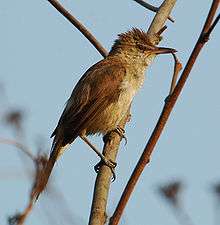Clamorous reed warbler
The clamorous reed warbler (Acrocephalus stentoreus) is an Old World warbler in the genus Acrocephalus. It breeds from Egypt eastwards through Pakistan, Afghanistan and northernmost India to south China, southeast Asia and south to Australia. A. s. meridionalis is an endemic race in Sri Lanka.
| Clamorous reed warbler | |
|---|---|
 | |
| Scientific classification | |
| Kingdom: | Animalia |
| Phylum: | Chordata |
| Class: | Aves |
| Order: | Passeriformes |
| Family: | Acrocephalidae |
| Genus: | Acrocephalus |
| Species: | A. stentoreus |
| Binomial name | |
| Acrocephalus stentoreus (Hemprich & Ehrenberg, 1833) | |
Habitat
Most populations are sedentary, but the breeding birds in Pakistan, Afghanistan and north India are migratory, wintering in peninsular India and Sri Lanka.
This passerine bird is a species found in large reed beds, often with some bushes. 3-6 eggs are laid in a basket nest in reeds.

Subspecies
Nine subspecies are recorded.
- A. s. stentoreus (Hemprich & Ehrenberg, 1833)
- A. s. brunnescens (Jerdon, 1839)
- A. s. amyae Stuart Baker, 1922
- A. s. meridionalis (Legge, 1875)
- A. s. siebersi Salomonsen, 1928
- A. s. lentecaptus E. J. O. Hartert, 1924
- A. s. harterti Salomonsen, 1928
- A. s. celebensis Heinroth, 1903
- A. s. sumbae E. J. O. Hartert, 1924
Description
Clamorous reed warbler is a large song thrush-sized warbler at 18–20 cm. The adult has an unstreaked brown back and whitish underparts. The forehead is flattened, and the bill is strong and pointed. The sexes are identical, as with most warblers. It is very like great reed warbler, but that species has richer coloured underparts.
There are a number of races differing in plumage shades. The migratory northern race has the richest brown upperparts, and the endemic Sri Lanka subspecies is the darkest form.
Like most warblers, clamorous reed warbler is insectivorous, but will take other small prey items.
The song is loud and far carrying, but less raucous than great reed warbler. It is a slow, chattering kereet-kereet-kereet with typically acrocephaline whistles and mimicry added.
References
- BirdLife International (2013). "Acrocephalus stentoreus". IUCN Red List of Threatened Species. 2013. Retrieved 26 November 2013.CS1 maint: ref=harv (link)
- Warblers of Europe, Asia and North Africa by Baker, ISBN
- Birds of India by Grimmett, Inskipp and Inskipp, ISBN
| Wikimedia Commons has media related to Acrocephalus stentoreus. |
